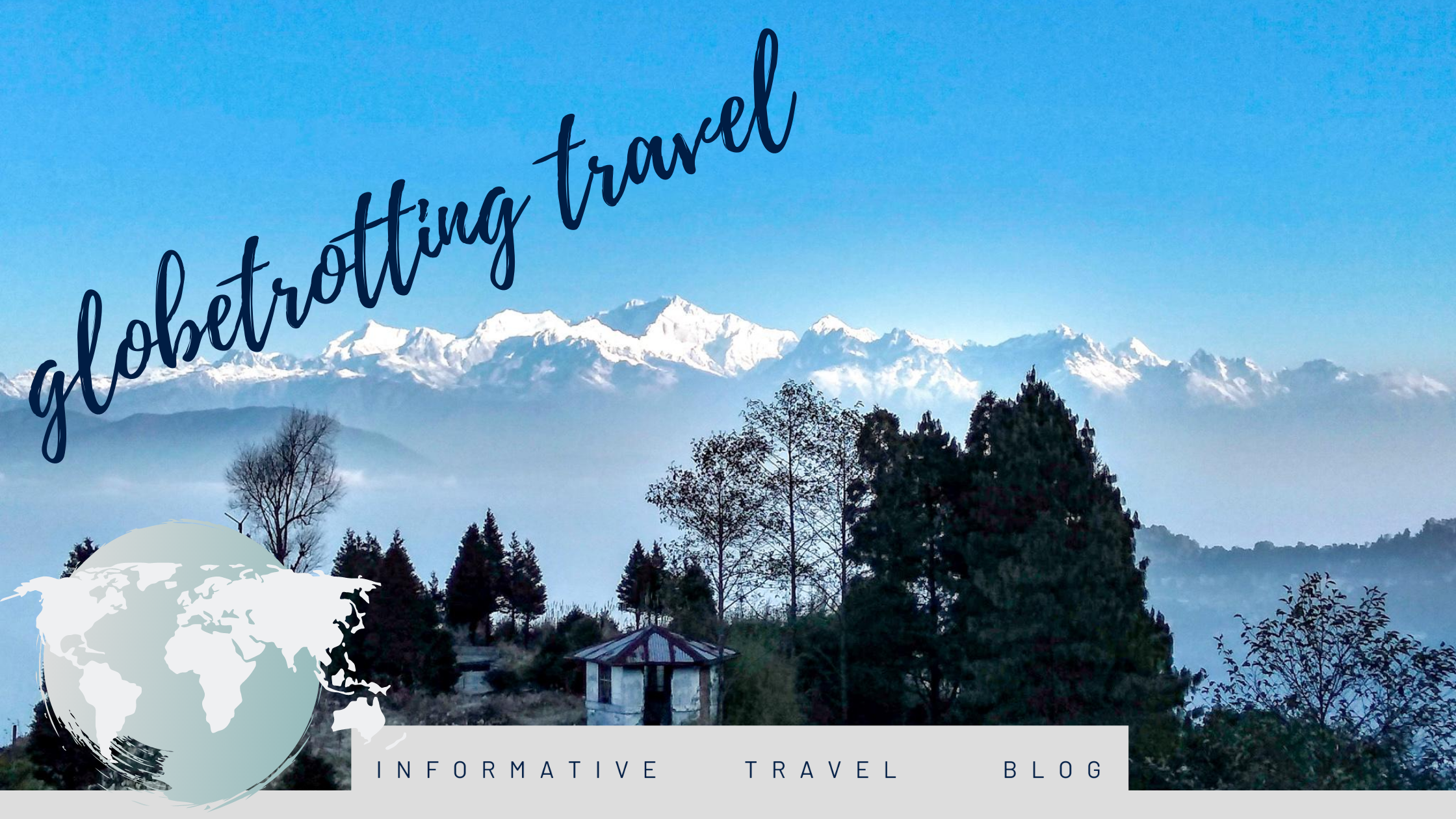“The city of four faces”.
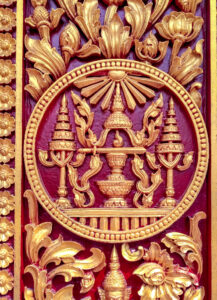
See photos
“It reminds us to be wary of people and regimes which ignore human dignity. No political goal or ideology, however promising, important, or desirable it may appear, can ever justify a political system, in which the dignity of the individual is not respected”.
Joachim Baron von Marschall, Germany’s ambassador to Cambodia.
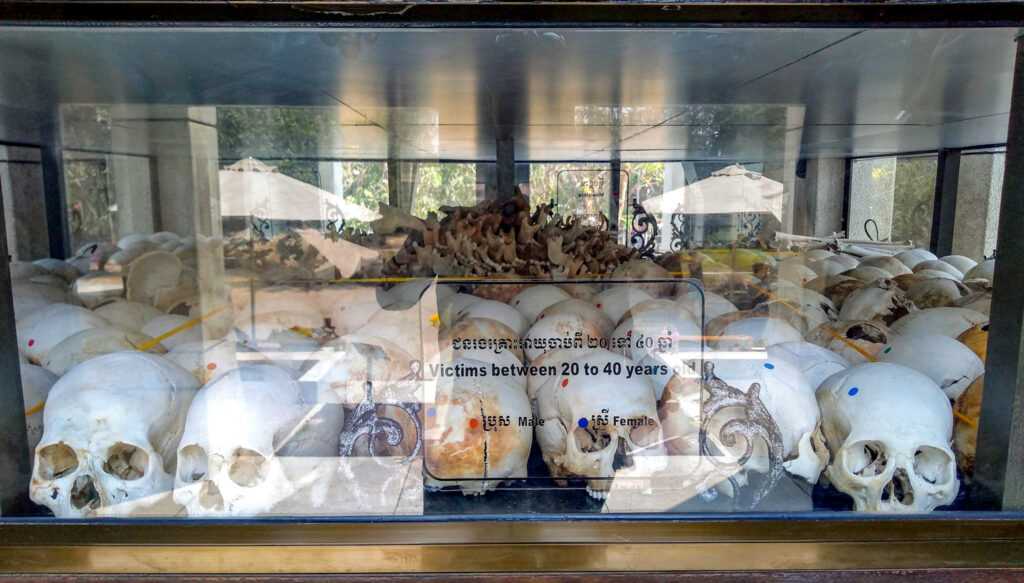
Where is Phnom Penh?
The city of Phnom Penh is in the south-central region of Cambodia. It sits on the banks of the Tonlé Sap, Mekong, and Bassac Rivers. The city was founded in 1372. It became the national capital in 1434 following the fall of Angkor. Remaining so until 1497.
Regaining its capital status during the French colonial era in 1865. It is noted for its historical architecture and attractions. By the 1920s, Phnom Penh was known as the “Pearl of Asia”.
Overview
Cambodia gained its independence from the French in 1953. Phnom Penh prospered and underwent tremendous growth as the capital city of a newly independent country in the years that followed. As the Vietnam War spread into Cambodian territory, thousands of refugees from across the country flooded the city to escape the fighting.
When the King was deposed in 1970, by a military coup the monarchy was abolished. And the short-lived Khmer Republic was established. The republic proved disastrous both militarily and politically, giving strength to the Communist Party of Kampuchea (Khmer Rouge).
On 17th April 1975, the Khmer Rouge forcibly evacuated the entire city. Its residents were evacuated from the city and forced to work on rural farms. Tuol Sleng High School in the city was taken over by Pol Pot’s regime and turned into the S-21 prison camp. A place where people were detained and tortured.
This is now the Tuol Sleng Genocide Museum.
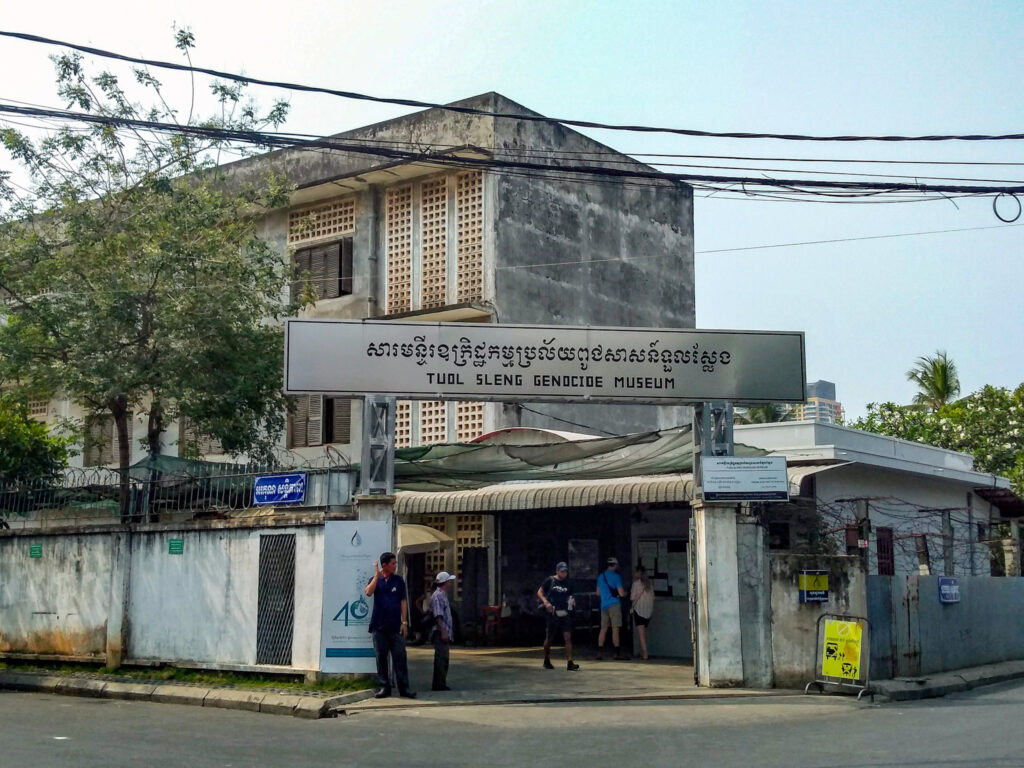
Nine miles outside the city is Choeung Ek (The Killing Fields). The Khmer Rouge marched prisoners from Tuol Sleng, where they were murdered and buried in pits.
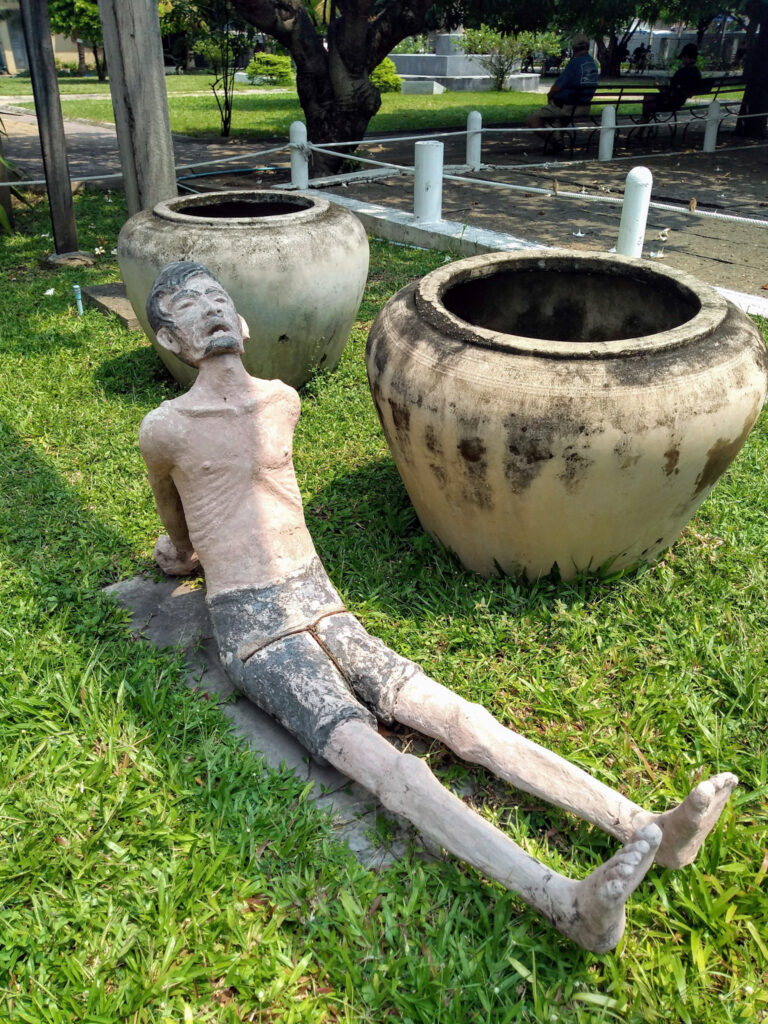
Now a memorial to those who were killed by the regime. In 1979 the city was liberated by the People’s Army of Vietnam and people began to return.
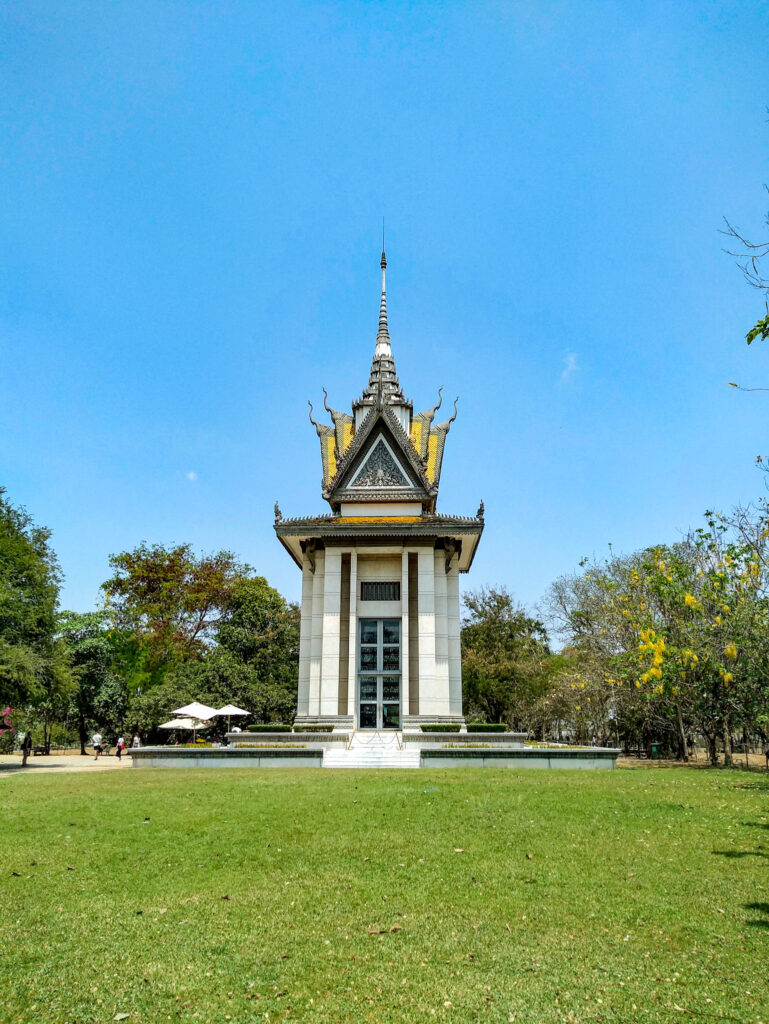
The main tourist attractions in the city are the Royal Palace with the Silver Pagoda and the National Museum. Constructed during the French colonial era in the late-19th century in the classical Khmer style, the National Museum houses a vast collection of Khmer antiquities. The French also left their mark, with various colonial villas, French churches, boulevards, and the Art Deco market Phsar Thom Thmei.
Getting there
Our journey from Siem Reap to Phnom Penh was by minivan. Katie to Phnom Penh also via minivan.
Our accommodation
During our time in Cambodia, we visited Phnom Penh twice. On the first visit, we chose to stay at the House Boutique Eco Hotel, then at the Balconitel Boutique Hotel. Both hotels booked through Booking.com. On our second visit, we chose to stay at the TeaHouse Hotel, again booked through Booking.com.
House Boutique Eco Hotel
Conveniently situated only 1 km away from Toul Sleng Genocide Museum and 2 km away from The Royal Palace. Our eco room was quite small. It had a king-size bed, quaint slatted wooden shutters, a wall-mounted LCD TV, tea and coffee making facilities, a mini-bar, a ceiling fan, and air conditioning.
The wash hand basin was located in the room and not in the ensuite bathroom. A clean, room but it was tired and in need of redecorating. The hotel has an outdoor swimming pool. The breakfast provided was good.
Balconitel Boutique Hotel
Conveniently situated only 1 km away from Toul Sleng Genocide Museum and 2.1 km away from The Royal Palace. Our room was large, bright, airy, and clean. The hotel has 2 swimming pools, one on the ground floor and the other on the roof. The restaurant serves good food at a reasonable price. Breakfast was very good.
TeaHouse Hotel
Relatively close to tourist attractions. Our room was spacious and clean. It had a king-size bed, a large TV, tea and coffee making facilities, a mini-bar, and air conditioning. The ensuite bathroom was spacious and housed a sizable shower. There is an outdoor swimming pool at the hotel. The restaurant serves good food at a reasonable price. Breakfast was buffet style and very good.
Places of interest
Despite being a bit rough on the edges, Phnom Penh retains some of its former French charms. Scattered along the grand boulevards there are a number of surviving French colonial buildings, intermingled with modern architecture.
The beauty that made it a ‘Paris of the East’ before 1970 is hidden beneath the modern day city. Phnom Penh is slowly gaining high rise buildings, traffic lights, and Western style shopping centres. Overall it still remains one of the most undeveloped capitals in Asia.
The innermost part of the city, known as “riverside” is where most tourists go. It has cafés and restaurants along the walkable promenade. Take a pleasant stroll at night it’s lined with parks. As well as the beautifully ornate Royal Palace, Silver Pagoda, and the National Museum.
The heart of the city has a massive, art deco, Central Market. A 1930’s covered market selling everything from flowers to video games. Recently renovated, its architecture alone makes it worth a visit.
Tourist sights are few and far between. Making the city a place to relax, watch the street life, and absorb the local culture. It is unfortunate that two of the city’s most popular tourist attractions are the memorials to the horrors and brutality carried out during the Khmer Rouge regime. Having said that, these are must see monuments, as the time they represent is a major part of Cambodian history.
The Tuol Sleng Genocide Museum
Tuol Sleng Genocide Museum tells the harrowing and horrific history of the Cambodian genocide. Formerly a secondary school it was used as a Security Prison 21, also referred to as S-21, during the Khmer Rouge regime from 1975 until its fall in 1979.
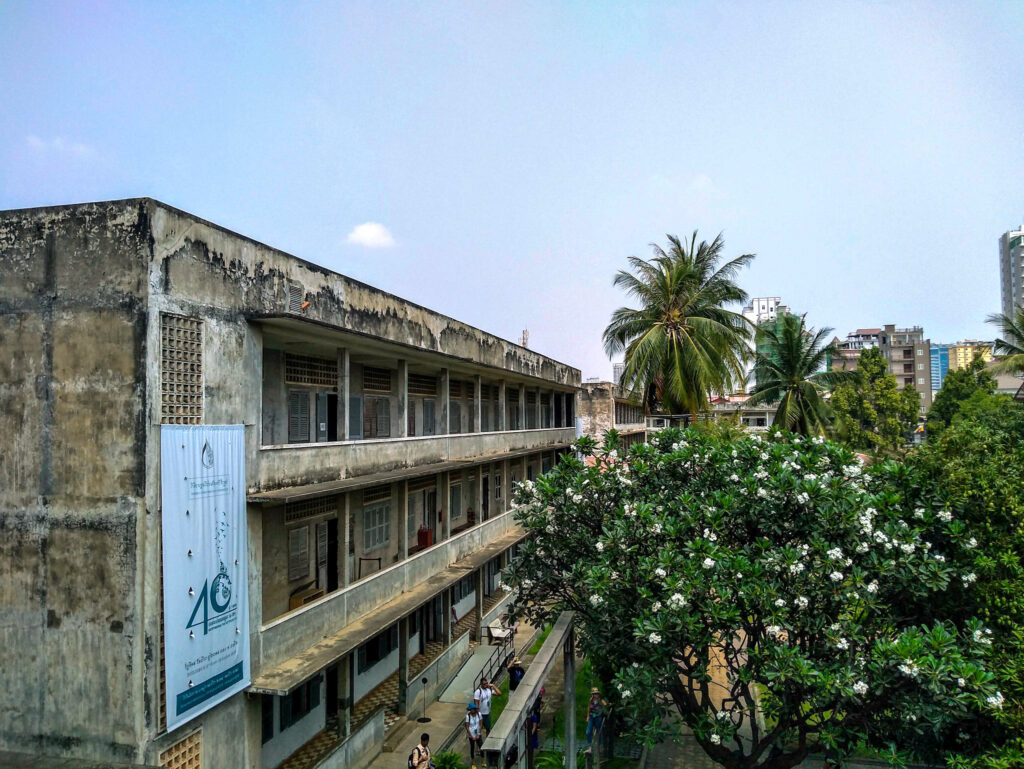
The buildings are preserved, with some rooms being left as they were when the Khmer Rouge were driven out in 1979. The regime kept extensive records, including thousands of photographs. Several rooms of the museum contain boards displaying black and white photographs of some of the estimated 20,000 prisoners who passed through the prison.
The site has four main buildings, known only as A, B, C, and D.
Building A holds the large cells in which the bodies of the last 14 victims were discovered. Victims having been slaughtered by the guards as they fled the advancing Cambodian and Vietnamese armies.
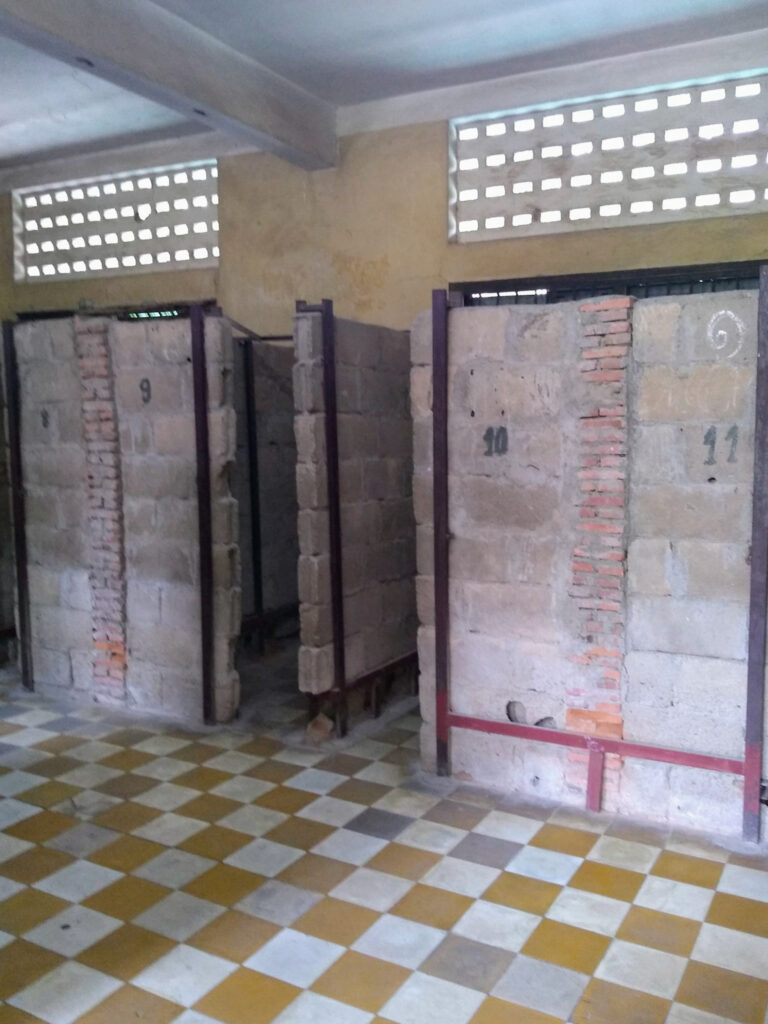
Building B holds the galleries of photographs.
Building C contains the rooms prisoners were kept in. Some divided into tiny inhuman cells, others where mass prisoners were shackled together.

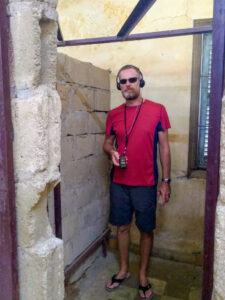
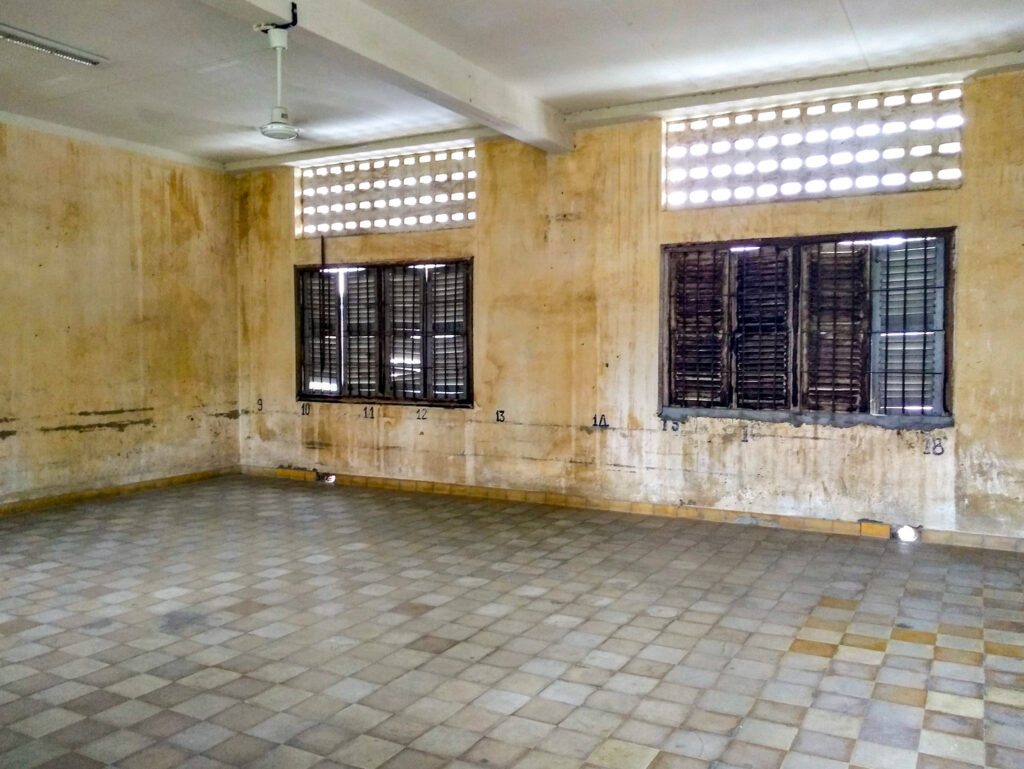
Building D contains artifacts that include some of the instruments of torture used by the guards.
It is estimated that from 1976 to 1979, 20,000 people were imprisoned here. S-21 was just one of at least 150 Khmer Rouge torture and execution establishments.
Death of Kaing Guek Eav (Duch)
The head of the government’s internal security branch, Kaing Guek Eav, was also referred to as Duch. He oversaw the horrific atrocities that took place at S-21. Among the last of the Khmer Rouge to flee Phnom Penh after it fell to the Vietnamese army, he made his way to the border of Thailand in May 1979.
On 31st July 2007, Duch was formally charged with war crimes and crimes against humanity. Found guilty of crimes against humanity, torture, and murder. On 26th July 2010, Duch was sentenced to 35 years imprisonment.
After serving ten years in prison, Duch died of lung disease on the 2nd September 2020, aged 77, at a hospital in Phnom Penh. Due to the complicated situation of COVID-19 in Cambodia at that time, he was cremated on the same day without a proper funeral.
Entry into the museum is 5 USD, plus another 3 USD for the audio guide, in our opinion, a must, to hear the full story about the prison.
Choeung Ek Genocidal Centre
Using the Pass app we booked a tuk tuk to take us to Choeung Ek Genocidal Centre, also referred to as the Killing Fields. Getting a tuk tuk off the street or through the hotel would have cost 15 USD return. Using the app it can be done for less than 4 USD each way. The journey out to Choeung Ek takes about 30 minutes, depending on the Phnom Penh traffic.
The tuk tuk pulled up outside the centre. Once just a simple orchard in the peaceful and beautiful Cheung Ek village, until the Khmer Rouge turned it into the infamous and horrific killing fields.

Entry to the centre costs 6 USD per person and includes an audio guide.
Between 1975 and 1978, approximately 17,000 men, women, and children, including nine westerners. Were transported here to be savagely and brutally murdered. Most of them had already been detained and tortured at Tuol Sleng Security Prison, S-21.
The remains of 8,985 people many of whom were bound and blindfolded. Were exhumed in 1980 from the mass graves on the site. 43 of the 129 communal graves here have been left untouched.
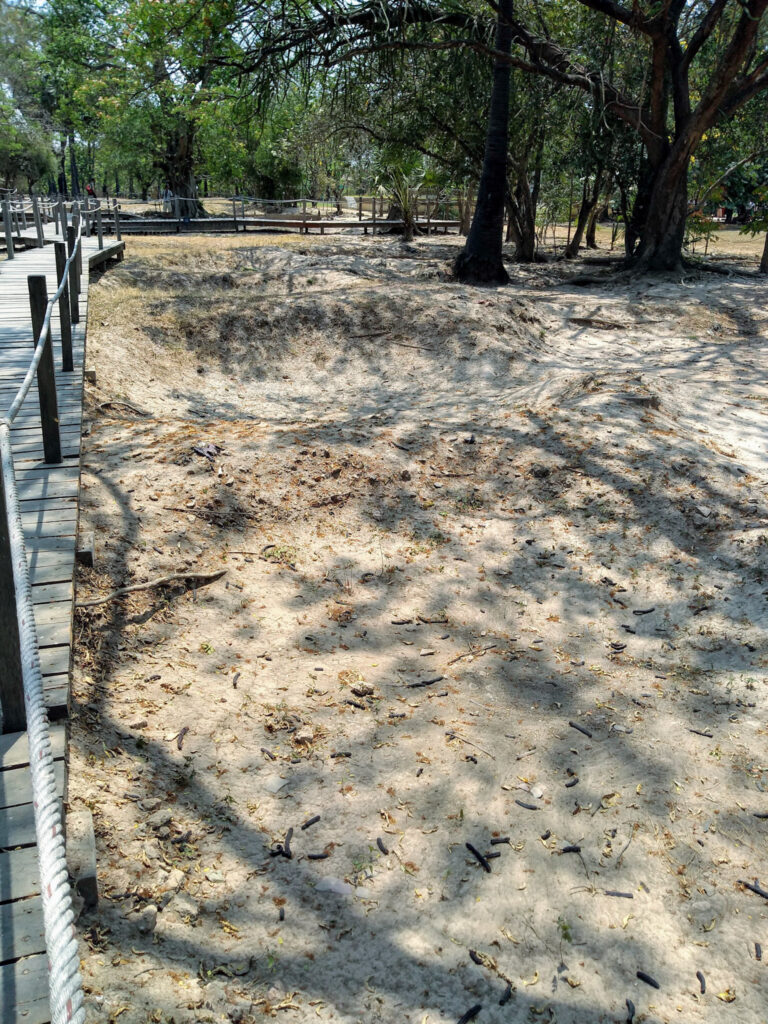
Fragments of human bone, teeth, and bits of cloth are still visible as they are unearthed by nature.
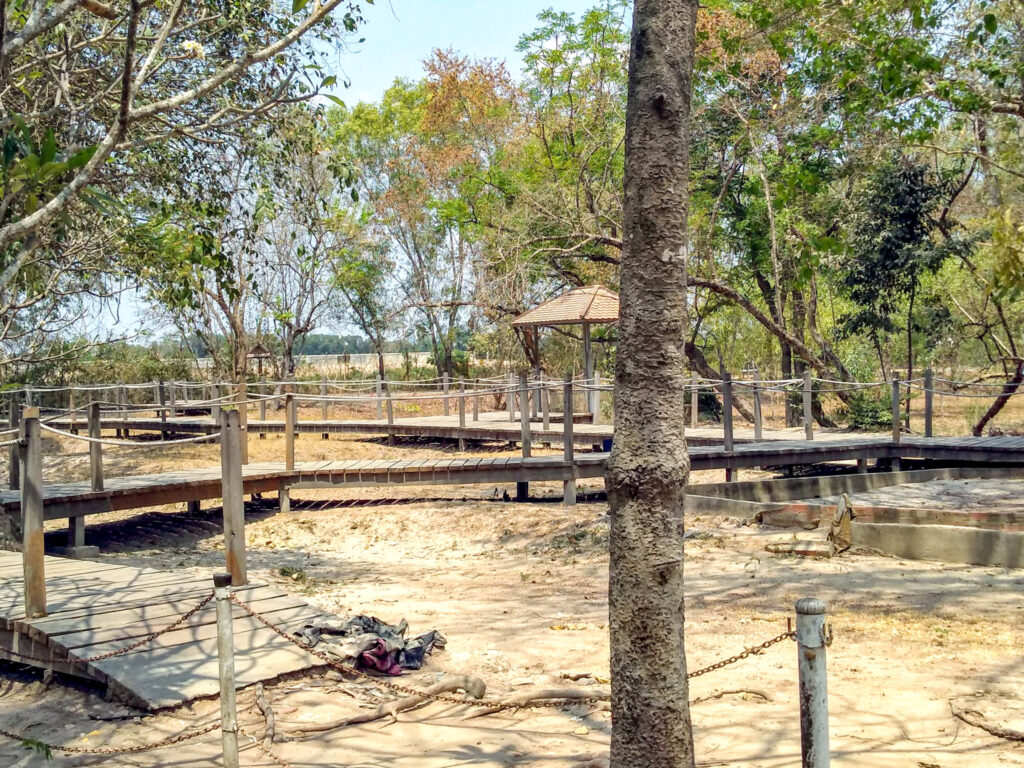
The audio guide provides the graphic history of the brutality that occurred here. It is a chilling reminder of the horrors the Khmer Rouge regime committed.
⚠️Warning some readers might find the following article upsetting.
Initially, a truck load of prisoners, 20 to 30, was brought here every 3 weeks. By 1978 this had escalated to 300 prisoners a day. If the Cadre couldn’t murder them all that day. Then the prisoners were kept in a darkened wooden hut to wait a further day before they were killed.
The murders took place during the day and at night. A blow to the head with a blunt instrument. After which their throats would be slit to ensure they were dead. This was to avoid wasting precious bullets. Many of the barbaric and cruel instruments are on display in the museum.
Their cries were muffled by the Regime’s propaganda. Broadcasted through loudspeakers mounted on the magic tree.
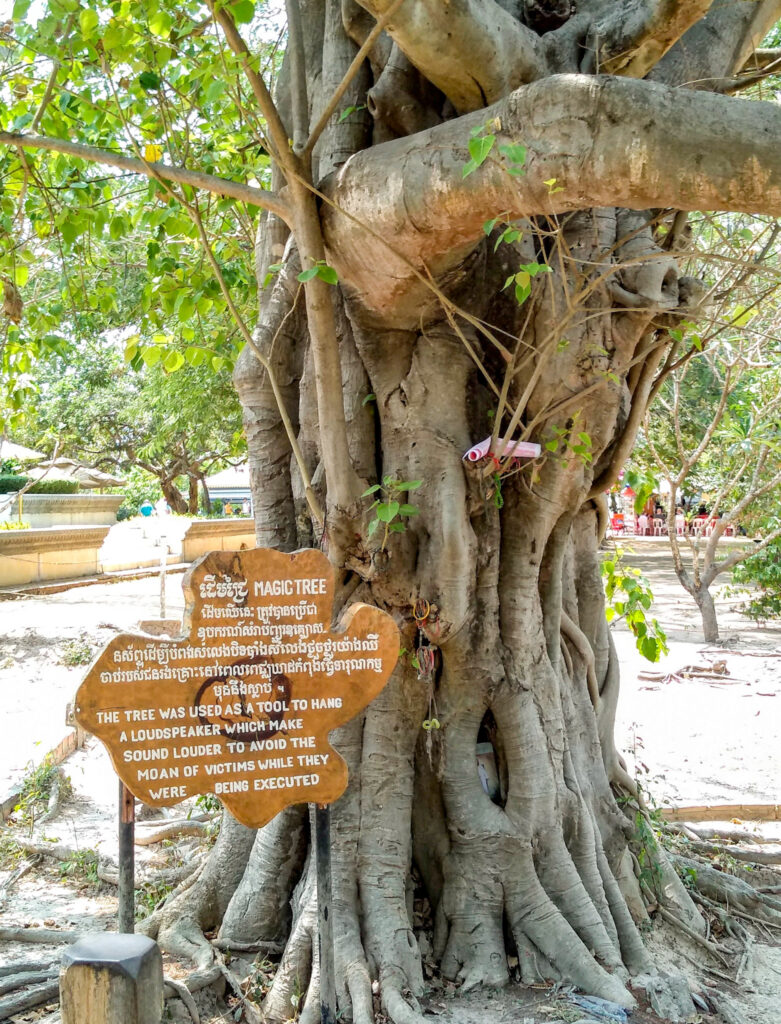
Babies were killed by bashing their heads against a tree. There are separate mass graves for men, women, and children. Former friends of Pol Pot who were executed here also had separate graves.
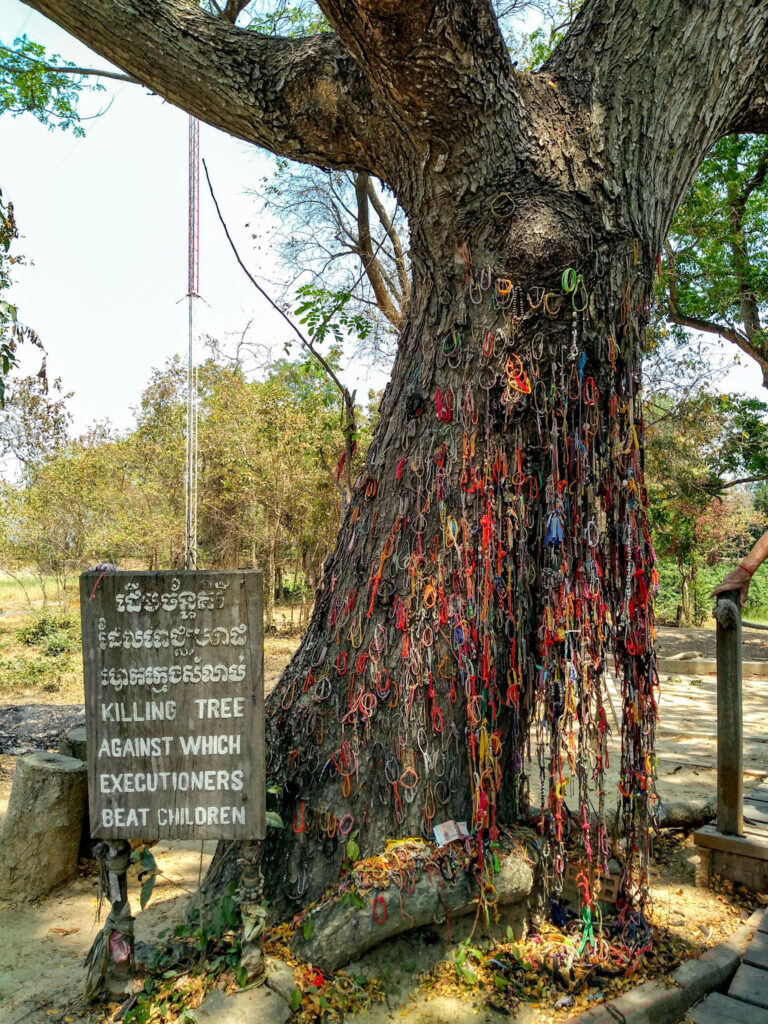
In memory of these atrocities, over 8000 skulls have been arranged behind the clear glass panels of a Memorial Stupa, erected in 1988. It is a spine chilling visit. Especially when it is pointed out that 1 in 4 of the Cambodian population of that time went missing.
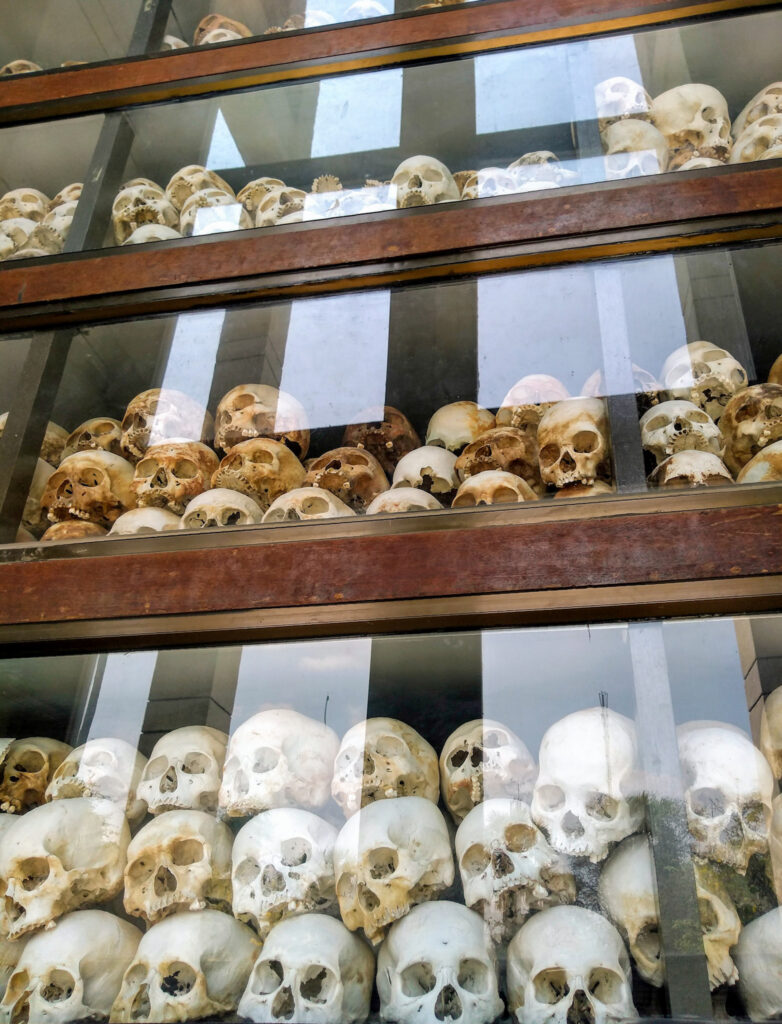
Presumed brutally murdered by the regime. This was not genocide of any particular ethnic or religious group, but the mass murder of a quarter of the countries people from all walks of life.
The Royal Palace
Kings of Cambodia have occupied The Royal Palace. Since it was built in the 1860s. With the exception of a period of absence when the country was under the rule of the Khmer Rouge.
The Royal Palace of Cambodia is a fine example of Khmer architecture with a slight French touch. As it was constructed by the French Protectorate in 1866.
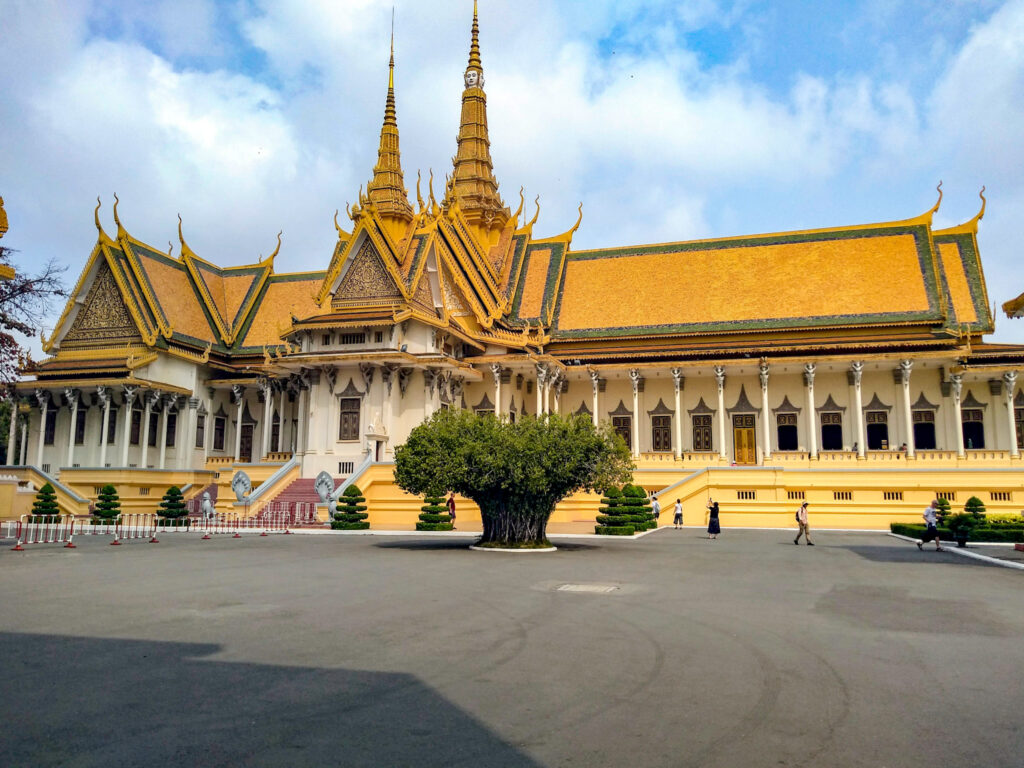
A popular tourist attraction in Phnom Penh. The palace is divided into four areas. To the south is the Silver Pagoda, to the north is the Khemarin Palace, to the centre is the Throne Hall and to the west is the Inner Court.
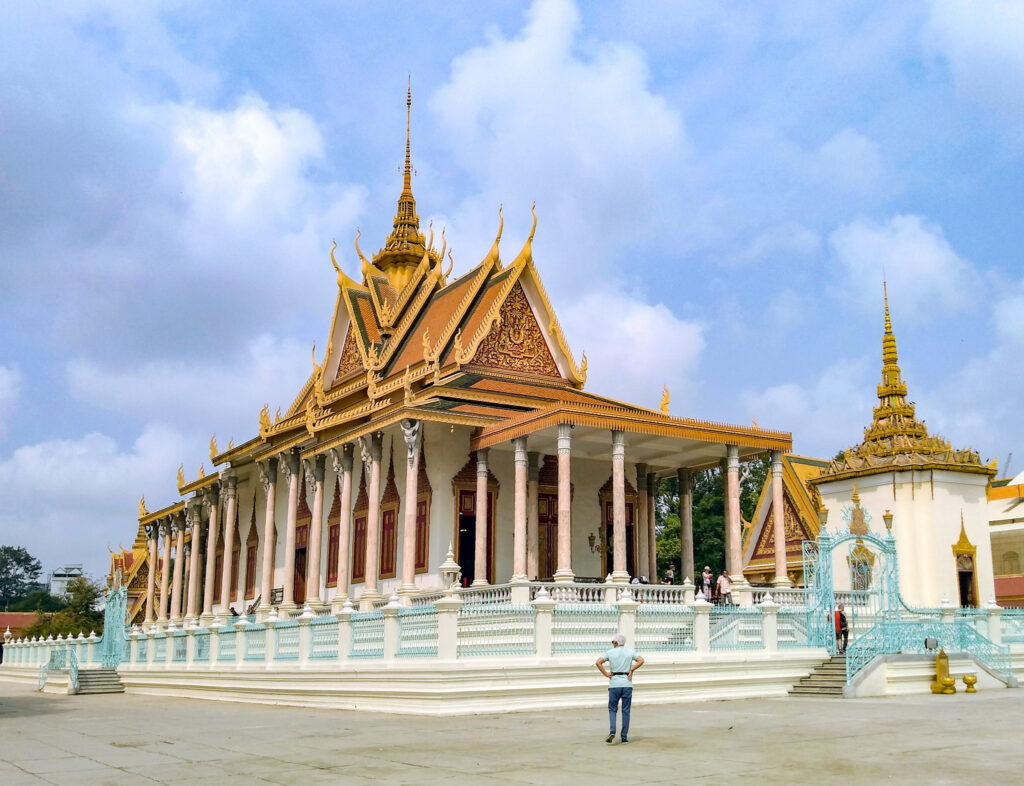
These are among the few public buildings in Phnom Penh really worth seeing. Our visit to the Royal Palace was fascinating. We wandered around the Silver Pagoda and the Throne Hall.
The King’s living area, which actually takes up half of the total palace ground area. Includes Khemarin Palace, Villa Kantha Bopha, Serey Mongkol Pavilion, royal gardens. Along with a number of other buildings and pavilions, is closed to the public.
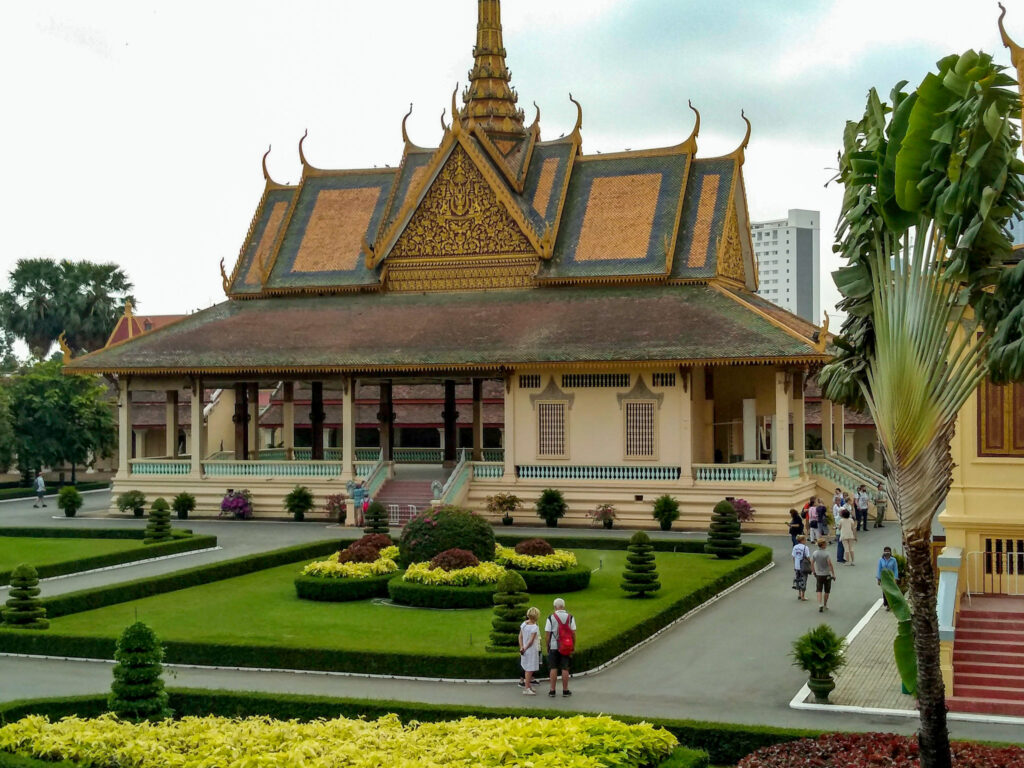
There were loads of artifacts on display in the air-conditioned rooms adjacent to the exit. Entry to the Palace was quite expensive at 10 USD per person.
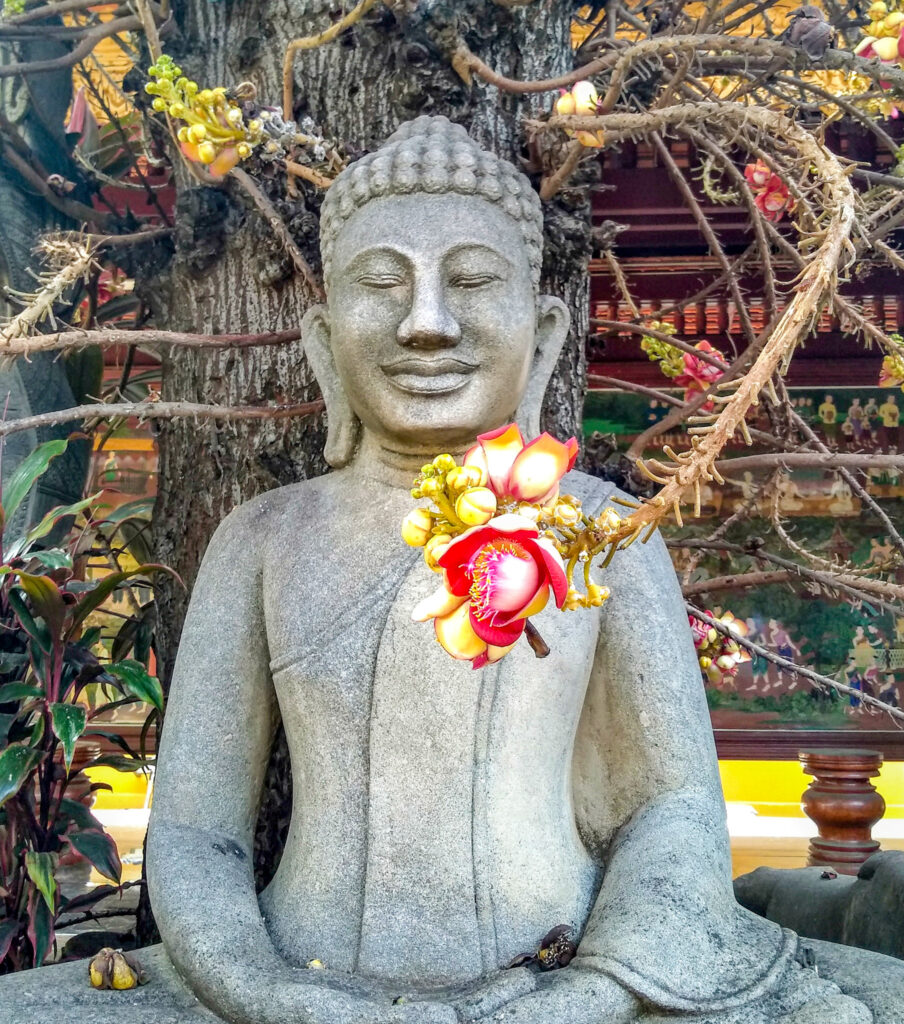
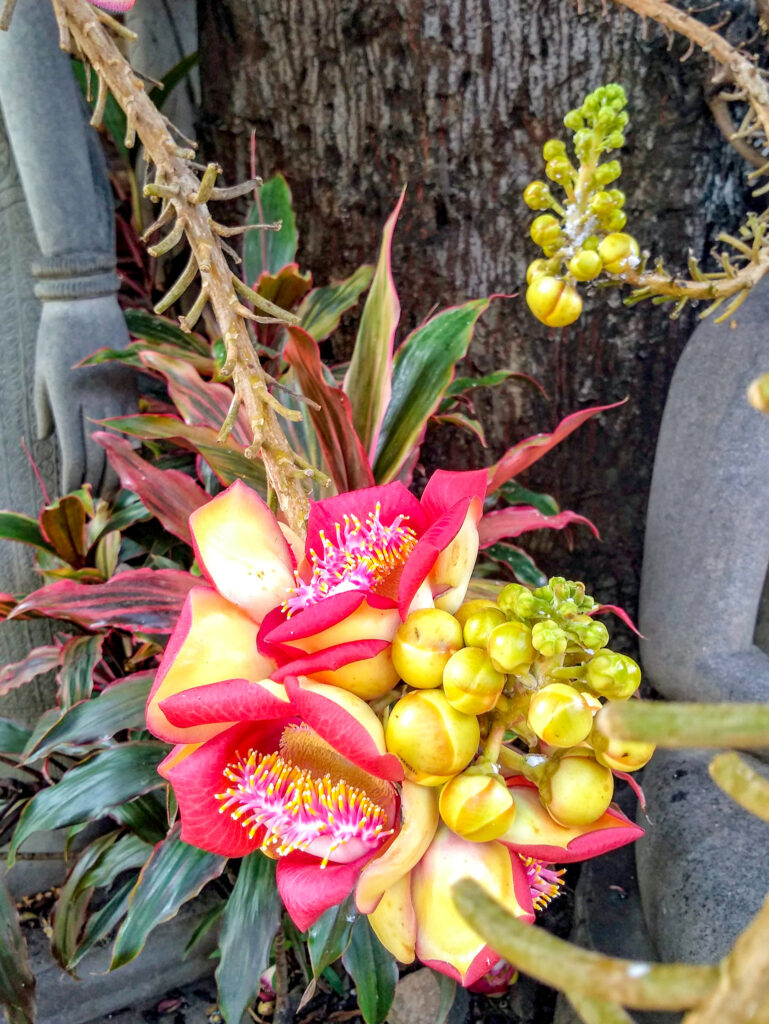
The National Museum of Cambodia
The National Museum of Cambodia houses one of the world’s largest collections of art from Cambodia’s “golden age” of Angkor. These include Khmer ceramics and bronzes. Along with the rest of the country, the museum didn’t escape the devastation of the Khmer Rouge regime.
The museum was closed between 1975 and 1979, during which time many objects were damaged or stolen. On the liberation of Phnom Penh, the museum was found to be in a state of disrepair. The roof was rotten and a colony of bats had made it their home. A quick repair and tidy up allowed the museum to reopen to the public in April 1979. Opening hours are 0800 hrs to 1700 hrs daily. Entry is $ 10 for foreigners, 500 Riel for Cambodians.
Wat Phnom
Built on the only hill in the city. Wat Phnom temple is noted more for its historic importance than a physical structure.
According to legend in 1372 a wealthy widower named Daun Penh came across a fallen koki tree floating in the river near her home. Inside the tree, she found four bronze statues of the Buddha. Amazed by this discovery, Penh and her neighbours built a shrine on a hill near her house. The locals called the small hill Phnom Penh, or “Penh’s Hill,” in her honour. The origins of the city’s name.
The park is a pleasant space, popular with the locals. Open from 0700 to 1830 hrs. Entry is $ 1 per person.
Independence memorial
Built in 1958 to commemorate Cambodia’s independence from France in 1953. The Independence Monument is the focal point during national celebrations. Royal or other officials light a ceremonial flame in the monument for these occasions.
Floral tributes will also be placed on the steps. The memorial park features a monument depicting Norodom Sihanouk, the “father king” of Cambodia.
Cambodia-Vietnam Monument
In the Botum Pagoda Park, close to the Independence Memorial, is the Cambodia-Vietnam Monument. The monument marks the Vietnamese liberation of the city from the Khmer Rouge regime in 1979.
During evenings at weekends, there is a multi-coloured fountain light show and communal music played.
The Central Market
Also referred to as the “New Grand Market” The Central Market is an Art Deco landmark of the city. The bright yellow building has a central dome, with four arms branching out diagonally across the block. The market houses countless stalls of all kinds, selling everything from T-shirts and postcards, electronic goods, secondhand clothes, and flowers.
Getting around
Public transport
The only form of public transport in the city is the bus. Modern air-conditioned units, currently running along 17 routes. The roads in Phnom Penh are good by Cambodian standards. However, you will still encounter potholes.
Line route
| 1A | Bus Depot ↔ Boeng Chhuk |
| 1B | Boeng Chhuk ↔ Prince Manor Resort |
| 2 | Kouch Kanong Roundabout ↔ Prek Samrong Bridge |
| 3 | Freedom Park ↔ Borey Santepheap 2 |
| 4A | Freedom Park ↔ Borey Santepheap 2 |
| 4B | Freedom Park ↔ Ang Snoul |
| 4C | Freedom Park ↔ Prek Kampoes Commune Hall |
| 5A | Bus Depot ↔ Aeon Mall Sen Sok |
| 5B | AEON Mall Phom Penh ↔ AEON Mall Sen Sok |
| 6 | Kouch Kanong Roundabout ↔ Bus Depot |
| 7 | Kilometer No 9 ↔ Boeung Chhouk |
| 8 | Kouch Kanong Roundabout ↔ St. 2004 Terminal |
| 9 | Borei Santepheap 2 ↔ Ang Snoul |
| 10 | St. 2004 Terminal ↔ Chba Ampov Market |
| 11 | Sleng Pagoda ↔ Stueng Meanchey Intersection |
| 12 | Cambodia Railway ↔ Cambodia Railway (Loop) |
| 13 | Cambodia Railway ↔ Deum Thkov Market Roundabout |
Services run from 0530 until 2030 hrs. Bus stops all contain the route map for that particular bus route. The free Stops Near Me app shows the full route map for all buses and bus stops in English. It also allows live tracking of buses, so you know when the next one is arriving.
Tickets
The fare for the public buses is 1,500 Riel per journey on the same bus irrespective of distance. Changing buses means you need to purchase another ticket. Only local currency, Riel is accepted. You cannot pay with USD on the buses.
Tuk tuks
Tuk tuks are the most convenient way to travel around towns and cities. The drivers will do their very best to overcharge you. They think that because you are a foreigner and travelling thousands of miles away from your home you can afford it.
There are three levels of pricing in Cambodia, tourist, ex-pat, and local. Knowing some basic Khmer might move you to the second category. Don’t be afraid to haggle, but be fair. Of course, it is entirely up to you how much you end up paying.
With us, it was the principle of overcharging tourists that we didn’t agree with. We always gave a tip to the genuine and fair drivers, for being just that.
Pass App
Getting around the tourist areas is cheaper using the online services of the Pass App.
Both cars and tuk tuks can be booked through this app. No arguments over the fare and cheaper than waving one down in the street.
The destination is entered at the time of booking. So no difficulty trying to explain where you want to go. The process of getting one can take a bit longer, but ultimately it’s worth it, in our opinion. Don’t worry if you haven’t got mobile data when you are out. All of the shops, bars, cafes, restaurants, and supermarkets have free wifi.
Moto taxi
A moto taxi involves you riding pillion on the back of a motorcycle or scooter. In our opinion, it is the cheapest and fastest way to get from somewhere to the hospital. As you can probably tell. We are not fans of this mode of transport.
Firstly being a couple, it doesn’t cater for us. Secondly, the insane way some of the motorcycles and scooters are driven leaves a lot to be desired. Lastly, bag snatching from tourists on moto taxis is commonplace.
Restaurants
Eleven One Kitchen
A popular restaurant, serving delicious and healthy Khmer food, freshly prepared with ingredients sourced directly from local farmers.
David’s Restaurant Homemade Noodles
Another busy restaurant. You can watch the noodles being freshly made. No atmosphere rushed and impersonal service and the food wasn’t, in our opinion, anything special.
